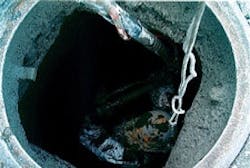Repairing an Aging Sewer System in North Carolina
| Related Searches from WaterInfoLink.com Sauereisen | Groundwater | Calcium Aluminate | Rocky Mount, N.C. |
The problem of groundwater infiltrating sewer systems poses major environmental and economic issues in many parts of the country. Conditions are ripe for infiltration in locations with aging municipal infrastructure and frequent precipitation. Because of this, many communities have to increase their treatment capacity.
A prime example is the town of Rocky Mount, N.C., located 45 minutes outside of Raleigh. The community was experiencing water infiltration problems and officials became determined to eliminate water inflow within their extensive network of aging manholes. In order to rectify the sewage overflow problem, city officials focused their attention on addressing the points of entry. Engineering firms have estimated that up to 50% of measured inflow and infiltration originates from deteriorated manholes. This often occurs through porous concrete or between grade rings and failing mortar joints of brick manhole structures.
The Solution
Concrete-based patching compounds are often the products used for the substrate repair of manholes. When needed, a protective topcoat or sealant is added. In Rocky Mount’s case, however, they wanted to use a single product rather than invest time and money in a two-step process. Since concrete can resemble a brittle sponge, a more specialized material was needed for Rocky Mount’s infrastructure.
That’s where Sauereisen’s calcium aluminate chemistry offered potential. Calcium aluminate cement resembles concrete in that it offers similar strength but has a matrix that is typically much less permeable. One of the primary means of characterizing this property is to measure the water vapor transmission (WVT) of a material. Based on the WVT of SewerSeal F-170 , Sauereisen’s lining possesses nine times less permeability. This gave Rocky Mount officials confidence that a 1/2-in.-thick lining of SewerSeal would effectively prevent the seepage of water through the manhole walls.
SewerSeal Technology
One of the challenges in working with calcium aluminates is that they tend to have stiffer handling properties than Portland-based materials. This is because the calcium aluminate products are usually fairly reactive. Applicators must be vigilant in their mixing and placement of calcium aluminate cement.
Sauereisen’s SewerSeal is supplied in 50-lb bags of powder and mixes with a surprisingly low level of water. At a mix ratio of 50 lb of powder to 92 ounces of potable water, new users routinely question whether the dry clumps of material in their mixing vessels will ever become fluid enough for practical use. The SewerSeal “wets out” quite nicely after approximately five minutes of mixing, so it is critical to mix thoroughly.
Application of SewerSeal typically occurs by spraying the product through spincasting equipment. Both high-horsepower, trailer-mounted mixing rigs have been used to deliver material along with more portable, low-horsepower equipment. In some cases it is convenient to cast calcium aluminate materials. Most applicators find calcium aluminates difficult to trowel. The material has a sticky consistency that helps in bonding, but it can stick to the trowel as well. In Rocky Mount’s case, they chose to shoot the product through a straight-shot nozzle, using a trowel simply to finish the material for a smoother surface texture.
SewerSeal’s versatility allows for use in manholes and lift stations regardless of the type of substrate—concrete, brick or steel. When F-170 is spincast, the application crew is typically stationed at ground level. This minimizes downtime and improves safety by preventing confined space entry.
By selecting the right product and application method for the job, Sauereisen’s SewerSeal coating will help this small town’s infrastructure stay strong and viable for years to come.
